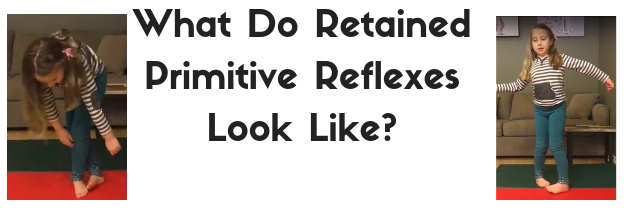primitive reflexes

Primitive Reflex Explained
Reflexes are genetically determined motor-behavioral patterns that must be integrated by every child into consciously controlled sensory-motor abilities and skills. They provide individual with the neurological foundation to process sensory input, program and control motor and behavioral actions, enhance memory and learning, and develop appropriate language and communication skills.
Muscular Disharmony and its Effects
Lack of muscle tone regulation beginning in infancy results in impulsive reactions that often turn into permanent behaviors as the child grows older. Impulsivity leads to lack of goal orientation and inner control, hyperactivity, chaotic and disorganised behaviour, inability to focus or follow instructions, impatience and irritability.
Poor muscle tone regulation is caused by a lack of integration in the excitation and inhibition processes in the reflex circuits. A deficit in muscle tone regulation expose the child to a wide variety of health challenges including but not limited to the following:
– High muscles tone at the back of the body along the spinal column results in forward leaning with head turning down, together with low abdominal muscle tone and diaphragm, all affect postural control. In an effort to release tension, your child may display impulsive movements involving balance mechanisms.
– Low muscles tone at arm, back of neck, palms and finger create a tendency for the child to keep arms flexed, results in poor dexterity.
– High leg muscles tone results in toe walking, frequent running and jumping.
– Low tone in oral-facial muscles leads to jaw tightening and decreased mobility.
- Increases tendency for hyperventilation, incomplete, rapid and shallow breathing, and holding breath during times of stress. The tendency for hyperventilation in individuals with chronic diseases is 4 to 7 times higher than the general population.
– imbalance in postural control can result in growth factor hormone deficit, leading to slow overall growth, and can affect intellectual development when the child does not notice the importance of external stimuli and escapes into their own world, thus being caught in a cycle of repetition of same stimuli over and over.
Righting Reactions
Righting reactions provide integrated movement between the head and trunk, and the body and gravity. They are under control at the mid-brain level and have to do with the relationship to gravity and the relationships between body segments. They underlie one’s ability to orient to the environment and to own body.
2 general categories of Righting Reactions:
Bringing the head into upright or vertical orientation in space in relationship to gravity
Bringing the head and trunk into mutual alignment with each other
Righting Reactions underlie movement transitions from lying to upright and turning in relationship to gravity and space. They are required for head lifting, rolling, sitting, crawling, creeping, standing, walking, running, etc., and maintaining postural alignment or tone. They are automatic reactions to a rapid loss of balance and weight shifting.
Gravity center shifts disproportionately from the back to the front, making the child incapable of maintaining normal balance. In order to compensate, the brain sends an order to tighten and/or lock the tendons in order to maintain a standing position. This posture then over-activates the defensive reactions of fight or flight.
Equilibrium Responses
Equilibrium Responses begins to develop the ability to transition from a horizontal position to vertical or sitting. They are automatic, varied patterns of movement to maintain balance by shifting the center of weight and/or base of support. They are elicited by:
Internal change of movement, such as shifting weight from one leg to another while climbing up a flight of stairs
External change or movement of support, such as when a rolling stool being pushed by a toddler rolls faster than she can ambulate.
Equilibrium Responses underlie and allow or support turning of the body through space and the ability to have a multidirectional relationship with gravity. They are mediated by higher brain centers, integrative centers such as the cerebellum, and they coordinate with, or are supported by integrated Primitive Reflex and Righting Reactions.
What is Tonic Labyrinthine Reflex
Tonic labyrinthine reflex can be inhibited if the Landau reflex is retained, leading to lower limb movement difficulty particularly into flexion, may walk in stiff and awkward manner, have difficulty in jumping and hopping.
1. arms and legs muscles have not been properly developed, leading to uncoordinated movements. Such uncoordinated movements can be resulted from tendency to walk on toes, and head forward etc.
2. temporal lobe of the brain is under activated, leading to difficulties in learning, reading, writing and computing mathematical problems.
Challenges in Visual System
– Eyes can be restless or immobile with dilated pupils.
– When eyes appear to freeze, the eyes provide a narrow limited visual span, poor visual attention and focus, and hyperactive peripheral vision.
– The child can demonstrate dependence or addiction to computers, tablets, cell phones, often with compulsive repetition of the same object or program over and over again.
Challenges in Auditory System
The child may demonstrate
– inadequate sound orientation, prioritising, focusing, and auditory fear paralysis reflex patterns.
– hypersensitive to surrounding sounds because the auditory system cannot prioritise important sounds, hearing all incoming sound input at the same time, causing over activation of auditory system, resulting in reactive behaviors such as covering ears, hitting ears, rapid turning or shaking head.